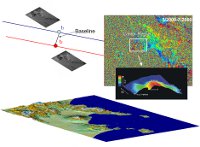

Ruch J, Acocella V, Storti F, Neri M, Pepe S, Solaro G, Sansosti E (2010). Detachment depth revealed by rollover deformation: An integrated approach at Mount Etna. Geophysical Research Letters, vol. 37.
Manconi A, Walter TR, Manzo M, Zeni G, Tizzani P, Sansosti E, Lanari R (2010). On the effects of 3-D mechanical heterogeneities at Campi Flegrei caldera, southern Italy. Journal of Geophysical Research-Solid Earth, vol. 215.
di Bisceglie M, Di Santo M, Galdi C, Lanari R, Ranaldo N (2010). Synthetic Aperture Radar Processing with GPGPU, IEEE Signal Processing Magazine, vol. 27, pag. 69-78.
Neri, M., Casu, F., Acocella, V., Solaro, G., Pepe, S., Berardino, P., Sansosti, E., Caltabianco, Lundgren, P., Lanari, R. (2009), Deformation and eruptions at Mt. Etna (Italy): A lesson from 15 years of observations, Geophysical Research Letters, vol. 36, ISSN: 0094-8276, doi: 10.1029/2008GL036151.
Fernández, J., Tizzani, P., Manzo, M., Borgia, A., González, P.J., Martí, J., Pepe, A., Camacho, A.G., Casu, F., Berardino, P., Prieto, J.F., Lanari, R. (2009), Gravity-driven deformation of Tenerife measured by InSAR time series analysis, Geophysical Research Letters.
Trasatti, E., F. Casu, C. Giunchi, S. Pepe, G. Solaro, S. Tagliaventi, P. Berardino, M. Manzo, A. Pepe, G. P. Ricciardi, E. Sansosti, P. Tizzani, G. Zeni, and R. Lanari (2008), The 2004–2006 uplift episode at Campi Flegrei caldera (Italy): Constraints from SBAS-DInSAR ENVISAT data and Bayesian source inference, Geophysical Research Letters, vol. 35, L073078, doi:10.1029/2007GL033091.
Casu, F., Manzo, M., Pepe, A., Lanari R. (2008), SBAS-DInSAR Analysis of Very Extended Areas: First Results on a 60,000 km2 Test Site, IEEE Geoscience and Remote Sensing Letters, vol. 5, no. 3, doi:10.1109/LGRS.2008.916199.
Tizzani, P., Berardino, P., Casu, F., Euillades, P., Manzo, M., Ricciardi, G. P., Zeni, G., Lanari, R. (2007), Surface deformation of Long Valley caldera and Mono Basin, California, investigated with the SBAS-InSAR approach, Remote Sensing of Environment Journal, 108, pp. 277-289, doi: 10.1016/j.rse.2006.11.015.
Casu, F., Manzo, M., Lanari, R. (2006), A quantitative assessment of the SBAS algorithm performance for surface deformation retrieval from DInSAR data, Remote Sensing of Environment Journal, 102, pp. 195-210, doi: 10.1016/j.rse.2006.01.023.
Borgia, A., Tizzani, P., Solaro, G., Manzo, M., Casu, F., Luongo, G., Pepe, A., Berardino, P., Fornaro, G., Sansosti, E., Ricciardi, G. P., Fusi, N., Di Donna, G., Lanari, R. (2005). Volcanic spreading of Vesuvius, a new paradigm for interpreting its volcanic activity. Geophysical Research Letters, 32, L03303, doi:10.1029/2004GL022155.
Pepe, A., Sansosti, E., Berardino, P., Lanari, R. (2005). On the Generation of ERS/ENVISAT DinSAR Time-Series via the SBAS technique. IEEE Geoscience and Remote Sensing Letters, 2, 3, pp. 265-269.
Bonaccorso A. , Sansosti E. , Berardino P. (2004). Modelled deformation pattern from terrestrial and satellite geodetic data and observed pattern from SAR for inferring magma storage sources at Mt. Etna during the 1991-93 eruption”, Pure and Applied Geophysics (PAGEOPH), Vol. 161, No.7, May.
Lanari R., Zeni G., Manunta M., Guarino S., Berardino P., Sansosti E. (2004) “An Integrated SAR/GIS Approach for Investigating Urban Deformation Phenomena: a case study of the city of Napoli, Italy”, International Journal of Remote Sensing, vol. 25.
Lundgren, P., Casu, F. , Manzo, M., Pepe, A., Berardino, P., Sansosti, E., Lanari, R. (2004), Gravity and magma induced spreading of Mount Etna volcano revealed by satellite radar interferometry, Geophysical Research Letters, 31, L04602, doi: 10.1029/2003GL018736.
Lundgren, P. Berardino, M. Coltelli, G. Fornaro, R. Lanari, G. Puglisi, E. Sansosti e M. Tesauro (2003). “Coupled magma chamber inflation ad sector collapse slip observed with synthetic radar interferometry on Mt. Etna”, Journal of Geophysical Research, 108, n. B5, 2247-2262.
P. Berardino, M. Costantini, G. Franceschetti, A. Iodice, L. Pietranera, V. Rizzo (2003). “Use of differential SAR interferometry in monitoring and modelling large slope instability at Maratea (Basilicata, Italy)”, Engineering Geology, 68, 31-51.
G. Fornaro, F. Serafino, F. Soldovieri (2003). “Three Dimensional Focusing With Multipass SAR Data”, IEEE Trans. Geosci. Remote Sens., vol. 41.
R. Lanari, P. Berardino, S. Borgström, C. Del Gaudio, P. De Martino, G. Fornaro, S. Guarino, G. P. Ricciardi, E. Sansosti and P. Lundgren (2003). “The use of IFSAR and classical geodetic techniques for caldera unrest episodes: Application to the Campi Flegrei uplift event of 2000”, Journal of Vulcanology and Geothermal Research.
Berardino, P., Fornaro, G., Lanari, R., Sansosti, E. (2002). A new Algorithm for Surface Deformation Monitoring based on Small Baseline Differential SAR Interferograms. IEEE Transactions on Geoscience and Remote Sensing, 40, 11, pp. 2375-2383.
SRV “Sistema Rischio Vulcanico”
MORFEO “MOnitoraggio e Rischio da Frane con dati EO”
SIGRIS “Sistema di osservazione spaziale per la Gestione del Rischio Sismico”